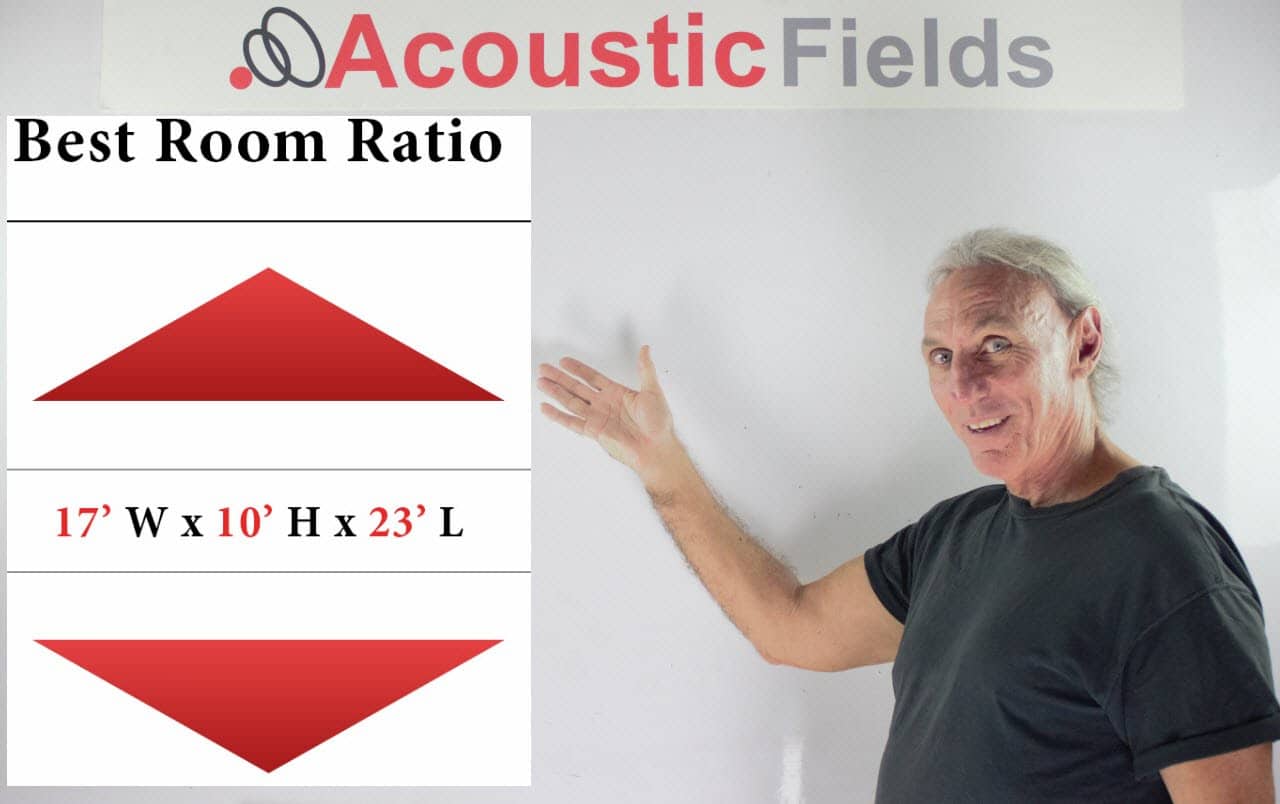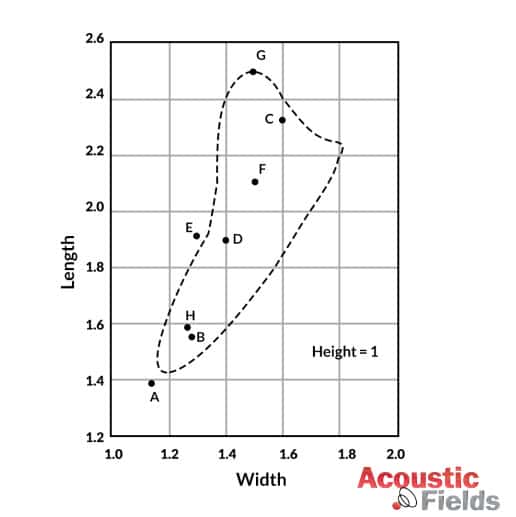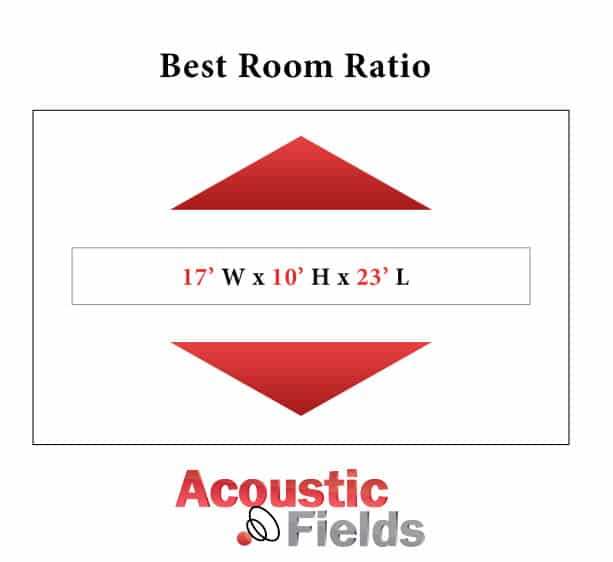We get a lot of questions from people on proper room size, dimensions and volume. What is a good size to have? What is not a good room size to have? So today we’re going to talk about some good room ratios and at the end of the video I’m going to give you a graphic on a nice room size to look at when you’re considering rooms.
Obviously usage has a big part in it. Live room is different from control, even control and mastering are different. So usage has a big impact on room size and volume. But lets just today work on some general concepts and ideas so you can kind of get an understanding on what is a good room size and what isn’t for your particular usage.
One of the engineers who is quite famous for his studies in room modes and unwanted pressure issues in rooms is an engineer named Bonello from Beunos Aires and he came up with this Bonello graph. Basically its a graph of different ratios you can use and apply your room size that you have to work to this graph and see how it fits and if it fits within a criteria then you’ll be able to see if its a good fit.
So what is the Bonello Graph?
Basically it divides the low end of a room and different room sizes and volumes, and it looks at everything below 200 cycles. As you’ll know from my past videos and articles you’ll know I’m a real stickler about the 200 Hz and below and the 200 cycles and above because of the wave lengths in today’s rooms, we have to allow for this 200 cycle and below wave.
So he looked at the low end and divided it into one third octave bands and why did he do that? He did it because one third octave bands is how we hear. This is human hearing processing. Now I know we use one 24th and one 12th in our analysis when we look at things, but for human hearing the one third octave is what he used and it works well for this process.
Why is 200 Hz. so important?
He looked at the number of modes that were below 200 cycles in a whole series of width, height and length dimensions. And he came up with this graph that allowed these modes to be separated by 10 Hz increments or higher. So he came up with a way of looking at room sizes and room ratios and proportions where the room modal structure was 10 Hz apart. He calculated that 10 Hz. was a nice spread between the modes to not cause so many audible differences in the presentation of the signal of the room.
And what did Bonello try and do with all this information below 200 cycles that he discovered and the room mode spacing of 10 Hz. apart? Well he discovered that each one third octave band should have more modes than the proceeding one to minimize audible distortions within the room. So he discovered more modes than the proceeding one when you look at the analysis or at least the same number of modes than the proceeding one.
So these are criteria that he used to evaluate and come up with this general guideline that we’re going to use. Is this the end and is this the final way to do things? No, because it depends on room usage and pressure levels and things like that. But it’s a great start and I think it will help you kind of decide where your room fits into this situation.
Modal coincides are not tollerated.
What is a modal coincidence? Its when you have a dimension, a height, a width, a length that are the same. And when you send your room dimensions into me, I see a lot of room dimensions that are the same. Well this is called a coincident. So when you see that and when I respond to that to you then you know that’s not even a criteria that an evaluator who came up with the formula, namely Bonello, for determining room ratios, concidered. So he didn’t even look at that. If you had a room that had 2 dimensions that were the same, not even the mix and that’s the way I respond to most of you when you send that in. Very, very serious to have 2 dimensions that are the same.
So not tolerated there unless you had 5 modes in a one third octave band. Well, I think as time has gone on, this is an older way of looking at things. So we’re just going to say that modal coincides are not tolerated. So if you have 2 dimensions that are the same, we’re going to have to change that physically by adding a wall to your room, or changing a dimension.
How to apply the Bonello graph
So what is the Bonello graph? Its a way to look at a room size that you’re considering or a room size that you already have. Plug it into the formula in the below graphic and you’ll be able to see where your room fits into that formula and know that that’s a good start. We also need to consider pressure in the room, usage and things like that.
So in the below graphic you should realise that anything below the following dimension we have to look at differently. So a good break point for room dimensions is 17′ wide, 10′ tall and 23′ long. So if your room size is below that, we’re going to have to treat low frequency pressure differently than if it is above that and a little bit larger, which will mean concentrating on reverberation times.
So use the Bonello graph, plug your room dimensions in it and then look at the 17′, 10,’ 23′ as a break point and realize that if your room size is below that then our emphasis is really going to have to be on the low end and anything above that on the high end.
In Summary
So I hope that helps you. If you have any questions at any time I am always on hand to help answer them. Leave them in the comments section or email me at info@acousticfields.com. If you would like to learn more about room acoustics please sign up for my free videos and ebook by joining the mailing list here. I send room tuning tips and things for you to test in your room every Wednesday. They are easy to follow and really help you enjoy more of your music. And if you would like your room acoustic issues analysed for free by me then please fill in the form here and I will be happy to take a look for you.
Thanks and speak soon
Dennis










Hi Mr. Foley,
So I’m currently in the building phase of my studio as we speak and I’m building a much considerably smaller room with the dimensions of 16′ L x 10′ W x 8′ H. I don’t quite understand the Bonella chart so is there any suggestion or recommendation’s you can give to help treat the room right based off my dimensios and tame the low end? Or maybe shed some light on how to understand the chart. Thanks Buddy!
Eric Moser
Hi Eric,
Go to our web site at: http://www.acousticfields.com. Go to third tab at top marked ” free room analysis”. Fill out the requested info. Sit in your listening/monitoring seat and take photos of all four walls and ceiling. I will run your room size and volume against our data base and locate unwanted pressure frequency issues, their location and strength (amplitude). With this data, you will know how much, what type, and where the locate the correct absorption or diffusion technology. Our data base takes all the guess work out of the equation.
Thanks for your inquiry
Hi!,
Isn’t the Bonello graph you show on this post the same as Bolt’s (1946) suggested area?
Hi George, These graphs are very old technology. We have our own data base of built and measured rooms. If you have a room size and volume, fill out the information in this link:https://www.acousticfields.com/free-room-analysis/. Lets run your numbers against our data base and see what your issues are.
I’ve been digging through your video’s for the past few months and would love to hear your opinion. I’m looking for a rehearsal / performance / live recording space that may hold an additional 75-150 guests. I’m looking for a Levon Helm ‘Midnight Ramble’ type space (except smaller). What dimensions would be idea for me to look out for? Thanks!
Larry, Contact us at info@acousticfields.com